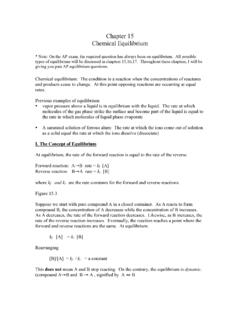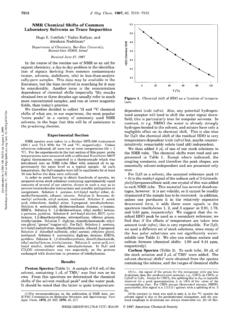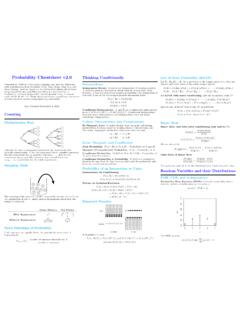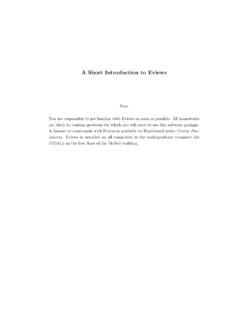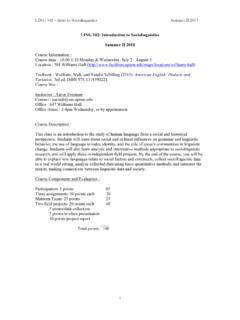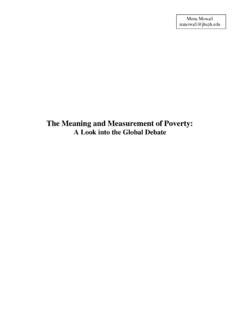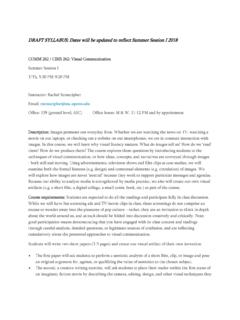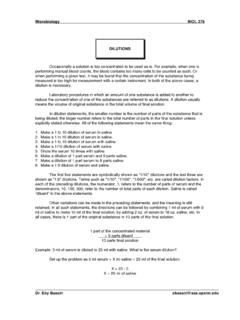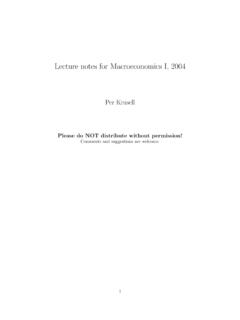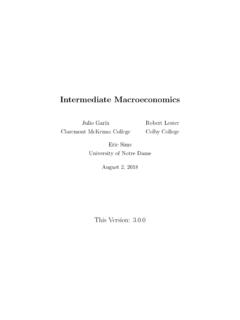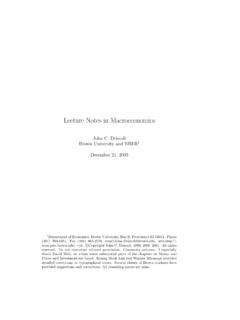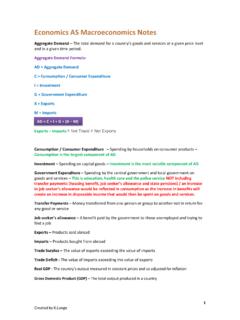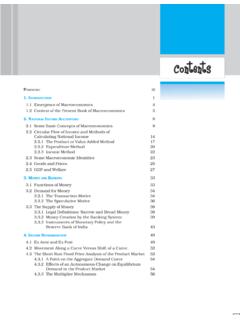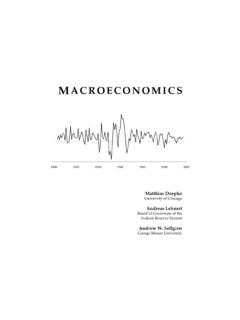Transcription of Macroeconomics: an Introduction
1 macroeconomics : an IntroductionJes us Fern andez-VillaverdeUniversity of Pennsylvania1 The Scope of macroeconomics Microeconomics: Object of interest is a single (or small number of)household orfirm. macroeconomics : Object of interest is the entire economy. We caremostly about:1. between Macro and Micro Micro and Macro are consistent applications of standard neoclassicaltheory. Unifying theme, EQUILIBRIUM APPROACH:1. Agents optimize given preferences and Agents actions are compatible with each other. This requires:1. Explicit about Models as are the Requirements of Theory? Well articulated models with sharp predictions. Good theory cannot be vague: predictions must be falsifiable. Internal Consistency. Models as measurement should we care about macroeconomics ? Self Interest: macroeconomic aggregates affect our daily life. Cultural Literacy: understanding our world. Common Welfare: Essential for policymakers to do good policy. Civic Responsibility: Essential for us to understand our Brief Overview of the History of macroeconomics I Classics (Smith, Ricardo, Marx) did not have a sharp distinction be-tween micro and macro.
2 Beginning of the XX century: Wicksell, Pigou. Keynes, The General Theory of Employment, Interest, and Money(1936). 1945-1970, heyday ofNeoclassical Synthesis: Samuelson, Solow, Klein. Monetary versus Fiscal Policy: Friedman, Brief Overview of the History of macroeconomics II 1972, Rational Expectations Revolution: Lucas, Prescott, Sargent. 1982, Real Business Cycles: Kydland and Prescott. 1990 s, Rich dynamic equilibrium models. Future?7 Why do Macroeconomist Disagree? Most research macroeconomist agree on a wide set of issues. There is wide agreement on growth theory. There is less agreement on business cycle theory. Normative issues. Are economist ideologically biased? Caplan (2002).8 National Income and Product AccountsJes us Fern andez-VillaverdeUniversity of Pennsylvania1A Guide to NIPA s What is the goal? When did it begin? Role of Simon Kuznets:1. Nobel Prize in Economics Prof. at Penn during the key years of NIPA creation. Gigantic intellectual achievement.
3 Elaborated by Bureau of Economic Analysis and published in theSur-vey of Current : How are macroeconomic aggregates measured?3 Gross Domestic Product (GDP)Canbemeasuredinthreedifferent, but equivalent ways:1. Production Expenditure Income GDP For 2003, nominal GDP was:$11,004,000,000,000 Population, July 2003 was:290,788,976 Nominal GDP per capita is roughly:$37,8425 Computing GDP through Production Calculate nominal GDP by adding value of production of all industries:production surveys. Problem of double-counting: USX and GM. Value Added=Revenue Intermediate Goods. Nominal GDP=Sum of Value Added of all GDP through ExpenditureC= ConsumptionI= (Gross Private) InvestmentG= Government PurchasesX=ExportsM=ImportsY=NominalGDPY C+I+G+(X M)7 Consumption (C) Durable Goods: 3 years rule. Nondurable Goods. Private Investment (I) Nonresidential Fixed Investment. Residential Fixed Investment. Inventory Investment. Stocks vs. and the Capital Stock Capital Stock: total amount of physical capital in the economy Depreciation: the part of the capital stock that wears out during theperiod Capital Stock at end of this period=Capital Stock at end of lastperiod+Gross Investment in this period Depreciation in this period Net Investment=Gross Investment Depreciation=Capital Stock, endthis per.
4 CapitalStock, Investment WhyincludedinGDP? Inventory Investment=Stock of Inventories at end of this year Stockof Inventories at the end of last year Final Sales=Nominal GDP Inventory Investment11 Government Purchases (G) Sum of federal, state, and local purchases of goods and services. Certain government outlays do not belong to government spending:transfers (SS and Interest Payments). Government (E)andImports(M) Exports: deliveries of US goods and services to other countries. Imports: deliveries of goods and services from other countries to theUS. Trade Balance=Exports Imports Trade Deficit: if trade balance negative. Trade Surplus: if trade balance positive13 Composition of GDP - Spendingin billion $in % of GDPT otal Nom. GDP11, , GoodsNondurable , , Private Investment1, in Inventory1, Purchases2, ,21, , , National Product11, GDP through IncomeNational Income: broadest measure of the total incomes of all AmericansGross Domestic Product (11, )+Factor Inc.
5 From abroad ( ) Factor Inc. to abroad ( )= Gross National Product (11, ) Depreciation (1, )= Net National Product (9, ) Statistical Discrepancy ( )= National Income (9, )15 Distribution of National Income1. Employees Compensation: wages, salaries, and fringe Proprietors Income: income of noncorporate Rental Income: income that landlords receive from renting, including imputed rent less expenses on the house, such as Corporate Profits: income of corporations after payments to theirworkers and Net interest: interests paid by domestic businesses plus interest earnedfrom and Capital Share Labor share: the fraction of national income that goes to labor income Capital share: the fraction of national income that goes to capitalincome. Labor Share=Labor IncomeNational Income Capital Share=Capital IncomeNational Income Proprietor s Income?17 Distribution of National IncomeBillion $US% Income less Prod. , of Employees6, of National IncomeIndustriesVal. %National Income 9, , Forestry, , Trade569, , Insur.
6 , Real , , , of the Income Concepts: Personal Income Income that households and noncorporate businesses receiveNational Income (9, ) Corporate Profits ( ) Net Taxes on Production and Imports ( ) Net Interest ( ) Contributions for Social Insurance ( )+Personal Interest Income (1, )+Personal Current Transfer Receipts (1, )= Personal Income (9, )20 Other Income Concepts: Disposable Personal Income Income that households and noncorporate businesses can spend, afterhaving satisfied their tax obligationsPersonal Income (9, ) Personal Tax and Nontax Payments (1, )= Disposable Personal Income (8, )21 Investment and Saving Private Saving (S): gross income minus consumption and taxes plustransfers From income sideY=C+S+T TR+NFP From expenditure sideY=C+I+G+X MI|{z}=Private |{z}Private Saving+T TR G|{z}Public Saving+M X+NFP|{z}Foreign Saving22 Some Nontrivial Issues Releases of Information and revisions. Methodological Changes. Technological Innovation. Underground Economy. Non-market activities.
7 IndicesQuestion: How to compute the price level?Idea: Measure price of a particular basket of goods today versus price ofsame basket in somebaseperiod24 Example: Economy with 2 goods, hamburgers and cokeht= # of hamburgers produced, periodtpht= price of hamburgers in periodtct= # of coke produced, periodtpct= price of coke in periodt(h0,ph0,c0,pc0) = same variables in period 0 Laspeyres price indexLt=phth0+pctc0ph0h0+pc0c0 Paasche price indexPat=phtht+pctctph0ht+pc0ct25 Problems with Price Indices Laspeyres index tends to overstate inflation. Paasche index tends to understate inflation. Fisher Ideal Index: geometric mean: (Lt Pat) Chain Nominal to Real GDP Nominal GDP: total value of goods and services produced. Real GDP: total production of goods and services in physical units. How is real GDP computed in practice, say in 2004?271. Pick a base period, say 19962. Measure dollar amount spent on Divide by price of hamburgers in 2004 and multiply by price in 1996.(this equals the number of hamburgers sold in 2004, multiplied by theprice of hamburgers in 1996 -the base period).
8 4. Sum over all goods and services to get real our example ..Nominal GDP in 2004 =h2004ph2004+c2004pc2004 Real GDP in 1996 =h2000ph1996+c2004pc1996 Note thatGDP deflator =Nominal GDPReal GDP=h2004ph2004+c2004pc2004h2004ph1996+c 2004pc199629 Measuring Inflation I t=Pt Pt 1Pt 1wherePtis the Price Level . GDP deflator: basket corresponds to current composition of GDP. Consumer Price Index (CPI): basket corresponds to what a typicalhousehold bought during a typical month in the base yearCPI =h1996ph2004+c1996pc2004h1996ph1996+c199 6pc1996 CPI important because of COLA Inflation II CPI may overstate inflation: Boskin Commission, New Goods. How to measure new technologies? David Cutler s example:1. Average heart attack in mid-1980 s costs about $199912,000 Average heart attack in late 1990 s costs about $199922,000 Average life expectancy in late 1990 s is one year higher than inmid-1980 Is health care more expensive now?31 Inflation over History I How much is worth $1 from 1789 in 2003?
9 1. $ using the Consumer Price Index2. $ using the GDP deflator. How much is worth $1 from 1861 in 2003?1. $ using the Consumer Price Index2. $ using the GDP over History II How much is worth $1 from 1929 in 2003?1. $ using the Consumer Price Index2. $ using the GDP deflator. How much is worth $1 from 1985 in 2003?1. $ using the Consumer Price Index2. $ using the GDP on Growth Rates Growth rate of a variableY(say nominal GDP) from periodt 1totis given bygY(t 1,t)=Yt Yt 1Yt 1 Growth rate between periodt 5andperiodtis given bygY(t 5,t)=Yt Yt 5Yt 534 Suppose that GDP equalsYt 1in periodt 1anditgrowsatrategY(t 1,t).How big is GDP in periodt?gY(t 1,t)=Yt Yt 1Yt 1gY(t 1,t) Yt 1=Yt Yt 1gY(t 1,t) Yt 1+Yt 1=Yt(1 +gY(t 1,t))Yt 1=YtHence GDP in periodtequals GDP in periodt 1,multiplied by 1plus the growth rate. Example: If GDP is $1000 in 2004 and grows at , then GDP in2005 isY2005=(1+ ) $1000 = $103535 Suppose GDP grows at a constant rategover time. Suppose at period0 GDP equals some numberY0and GDP grows at a constant rate ofg% a year.
10 Then in periodtGDP equalsYt=(1+g)tY0 Example: If Octavio Augustus would have put 1 dollar in the bank atyear 0AD and the bank would have paid a constant real interest rateof , then in 2000 he would have:Y2000=( )2000 $1 = $8,552,330,953,000which is almost the US GDP for last Reverse question: Suppose we know GDP at 0 and what constant rate GDP must have grown to reachYt,starting (1+g)tY0(1 +g)t=YtY0(1 +g)= YtY0!1tg= YtY0!1t 137 Example: In 1900 a country had GDP of $1,000 and in 2000 it hasGDP of $15,000. Suppose that GDP has grown at constant big must this growth rate be? Take 1900 as period 0,2000 asperiod 100,then= $15,000$1,000!1100 1= = Question: We know GDP of a country in period 0 and its growth rateg. How many time periods it takes for GDP in this country to double(to triple and so forth).Yt=(1+g)tY0(1 +g)t=YtY0 Since log ab =b log(a)log (1 +g)t =log YtY0!t log(1 +g)=log YtY0!t=log YtY0 log(1 +g)39 Suppose we want tofind the number of years it takes for GDP todouble, thetsuchYtY0= gett=log(2)log(1 +g) Example: withg= 1% it takes 70 years, withg=2%ittakes35years, withg= 5% it takes 14 with the Rest of the WorldTrade Balance = Exports ImportsCurrent Account Balance = Trade Balance + Net Unilateral Transfers Unilateral transfers: include aid to poor countries, interest paymentsto foreigners for US government debt, and grants to foreign researchersor Net wealth position of the US: difference between what the US is owedandwhatitowestoforeigncountries.
